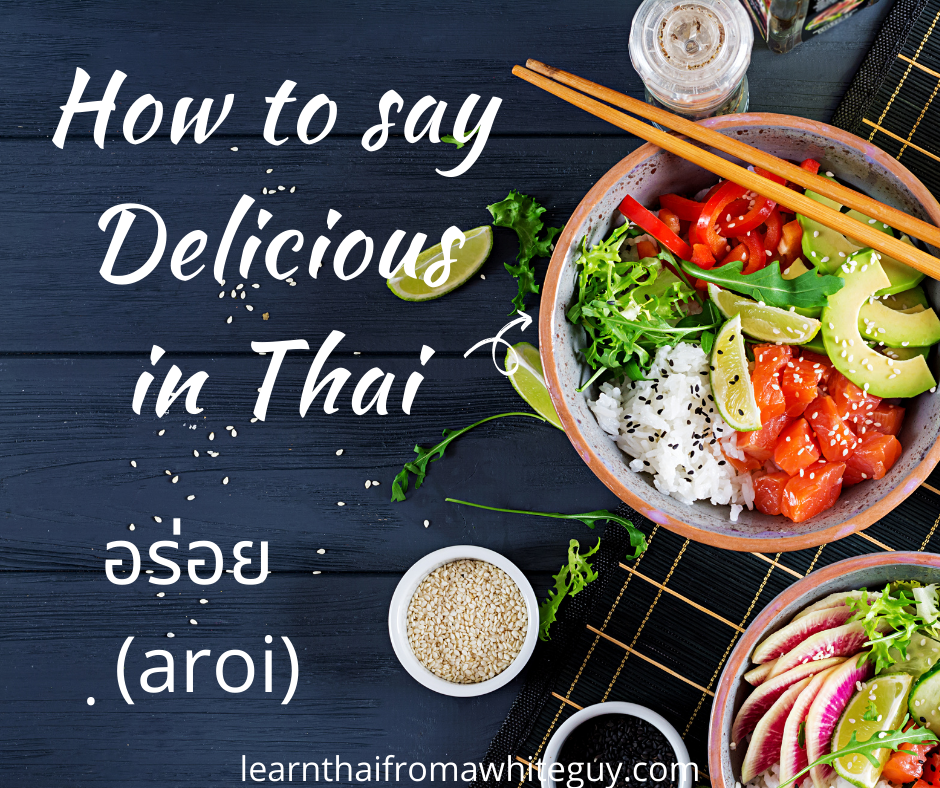Thai food is some of the best you’ll find anywhere in the world. Thailand often tops lists of “best street food in the world” such as this one by CNN. So it’s hardly surprising that Thai people are passionate about their food. If you’ve ever spent much time with Thai people, you’ll find that the conversation can often quickly turn to the subject of food.
In fact, food is so important within Thai culture that one of the most common ways to say hello in Thai language is by asking if the person you are greeting has eaten yet:
- กินข้าวรึยัง (gin khaao ru yang) – Have you eaten yet? (*Literally: eat rice or not yet?)
So if there’s one word that you should learn for your trip to Thailand, it’s “delicious” – you’re going to need it!

อร่อยมาก
The Word for Delicious in Thai for Every Situation
Luckily, this very useful Thai word does not require any pronunciation acrobatics so you should be able to say it correctly without too much effort.
Whether it’s dinner and a few drinks with your Thai friends or a formal business lunch – the word for delicious that you need to use is:
- อร่อย (ah-roi) – delicious
This can be used in both formal and informal situations but for formal situations just remember to add the polite particle ครับ (khrap) for male speakers OR ค่ะ (kha) for female speakers like this:
- อร่อย ครับ(ah-roi khrap) – It/this is delicious; It tastes good (polite, male speaker)
- อร่อย ค่ะ (ah-roi kha) – It/this is delicious; It/this tastes good (polite, female speaker)
It’s important to note that Thai people use their word for delicious far more often than most native English speakers do. This is likely based partially on the high quality of the food in Thailand, but it’s also in important cultural difference.
In English, we reserve the word for food that is ESPECIALLY tasty, while in Thai, it’s more of a question of “tastes great” or “doesn’t taste good.”
How to Say REALLY Delicious in Thai
If you’re very impressed with the food you’ve just eaten (which there’s a good chance you will be) – you can add มาก (maak) – very.
- อร่อยมาก (aroi maak) – It’s so delicious!
Basic Thai Grammar Point
In Thai language, nouns and adjective position is opposite to English. It will feel weird at first, but you’ll get used to it so don’t try to memorize this rule. Just remember one phrase like the one below.
For example, where we would say “red ball” or “delicious food,” in Thai, you are need to say “food delicious” or “ball red.”
- อาหารอร่อย (aahaan aroi) – delicious food
Here’s another simple example phrase:
- บ้านสวย (baan suay) – a beautiful house
How to Ask if the Food is Delicious in Thai?
Now that we know that aroi ( อร่อย) means “delicious,” the next thing we need to know is how to ask – “is the food good?” The structure for this is very simple:
- Adjective + ไหม (mai)
-
- ไหม (mai) – is a question word used at the end of a sentence to turn a sentence in to a yes or no question. Like both the words for “smells nice” and “smells bad,” it takes a RISING tone.
Example:
- อร่อยไหม (aroi mai) – Is it delicious? / Is it good?
In Thai you can answer this kind of yes or no question by answering with the verb or adjective that was used in the question. While there are words for yes and no in Thai, in most cases, “yes” does not work like it does in English.
So two simple and common answers to this question are:
Seven Degrees of Thai Deliciousness
The taste of food is very important in Thailand. This by no by means covers all possible ways to express your pleasure (or displeasure!) with a Thai dish, but it will give you a range of phrases to come back and learn.
- อร่อยมากๆ (aroi maak-maak) That’s very-very delicious!
- อร่อยมาก (aroi maad) That’s very delicious!
- อร่อย (aroi) That’s tasty; That’s good
- กินได้ (gin daai) I can eat that.
- เฉยๆ (cheuy cheuy) It’s fine.
- ไม่อร่อย (mai aroi) It’s not good.
- ไม่อร่อยเลย (mai aroi leuy) It’s awful / It’s terrible (literally: it’s not good at all)
How to Say That Looks Delicious in Thai
Thailand has some of the best markets in the world – from the floating markets of Bangkok to the vast, bustling Walking Street Night Markets of Chiang Mai. There are countless food stalls selling everything from fried rice to fried crickets. If you’re walking around the market with your Thai friends – you will at some point hear or want to say “that looks delicious.” The way to say “that looks delicious” in Thai is:
- น่ากิน (naa gin) – worthy of eating (appears like it would be nice to eat)
*In English, we might say “That looks good.” In Thai, you add น่า (naa) in front of a number of verbs to show that doing that ACTION would be pleasant/fun/nice or worthy of doing.
-
-
- น่าไป (naa ppai) – worthy of going (Appears/sounds like it would be good/fun to go there)
- น่านั่ง (naa nang) worthy of sitting (appears like it would be nice/comfortable to sit/chill there)
- น่าดู (naa doo) worth of seeing (appears like it would be worth watching)
- น่าอ่าน (naa aahn) worthy of reading (appears like it would be worth reading)
-
If you remember the Thai word for delicious mentioned above, you can also add this น่า (naa) in front of it as a different way of saying “looks like it would be good/pleasant to eat.”
- น่าอร่อย (naa aroi) – Which means something like: This appears/smells like if I tasted it, it would taste good.
Useful Thai Phrases with น่า (naa):
Another way to think about this pattern is that it’s comparable to adding “-able” in English so in the example below, the the meaning is literally: “loveable” or “worthy of love” although น่ารัก (naa rak) is always used as way to describe something or someone as “cute.” If you’d like to see more examples of this very common pattern, check out our full post on “How to Say Cute (and beautiful) in Thai.”
For example:
- เชียงใหม่น่าเที่ยว (naa tiiao) – Chiang Mai looks like a great place to visit
In this case น่าเที่ยว (naa tiiao) roughly translates as “a great place to visit” or “worth visiting”
- กระบี่น่าอยู่ (gra-bii naa yoo) – Krabi looks like a great place to live
In this sentence น่าอยู่ (naa yoo) translates as “looks like it’d be a great place to live”.
Thai Grammar Note:
Thai is a very contextual language. This means that we will often omit any information that is obvious. In the phrases above, we will know what is good to watch/eat/read based on who we are talking to and what we are looking at and/or talking about. If the speaker and listener know what we are talking about, you often don’t need to say it.
How to Say Food Smells Good in Thai
The food culture in Thailand is going to stimulate all of your senses, from all the vibrant colors of the food, the taste and of course the smell. If you walk around any food market in Thailand, there will be all kinds of food simmering, barbecuing and or being stir fried up. Your mouth will be watering from all the amazing smells. So another phrase you’ll need is “that smells good.”
-
หอม (hom) – (It/something) smells nice.
- *Not just limited to food.
How to Say Something Stinks or Smells Bad in Thai
On your walk around a Thai market at some point you are going to walk past a stall that’s selling durian. The first time you smell durian or ทุเรียน (thu-rian) in Thai you’ll be able to decide whether it’s a good smell or not. It’s powerful enough that many hotels try to ban people from bringing durian into the rooms by threatening a fine.
So if you smell a durian, you might not be using the word หอม (hom). If you don’t like the smell (and many people don’t!) you’ll want to know the following Thai word which is used for things that stink or smell bad. Rotten food, farts and smelly armpits (and sometimes durian!) all fall under the following Thai word:
Thai Tone Tip:
Both of these smell words in Thai have a rising tone. The rising tone in Thai is very similar to the way we make the word “Really?” rise up in English when we are looking to confirm if something is real. Click on each word a few times to try to get a feel for what a rising tone should sound like.
Learning the tones in languages like Thai takes some getting used to. You won’t always be able to hear a tone the first couple of times, but with a bit of practice and exposure, I promise your brain will get used to it. Thai has a set of tone rules that you can learn eventually be able to instantly know the tone of a word as soon as you see how it is spelled, but it does require a bit of practice. If you want to be able to speak Thai one day, it’s totally worth the time investment.
The Five Thai Flavors
When you are just starting to learn Thai, you might find that the topic of food is a great conversation starter since eating is something that you do every day and it’s something that most Thai people have passionate opinions on. So it’s worth having a few more food-related words up your sleeve when the conversation advances past อร่อย (aroi). If you are not used to eating Thai food, you might find that some of the flavours – รส (rot) – can be intense at first as it often involves a complex combination of flavors.
There are five main flavors which make up Thai cuisine. They are:
1 – Spicy
- เผ็ด (ped) – spicy
Spicy flavors come from chili พริก (prik) chili (fresh, dried whole or dried powdered) and พริกไทย (prik thai) pepper. Many Thai dishes will contain some level of spiciness to varying degrees depending on the dish.
One example of a spicy Thai dish is:
- ผัดกะเพรา (pad kra pao) – stir fried holy basil
This dish uses fresh chilis, stir fried with holy basil usually served with rice.
2 – Sweet:
- หวาน (waan) – sweet
Sweet flavors will usually come from palm sugar, coconut sugar or regular refined white sugar.
An example of a dish that has sweet flavors is:
- ส้มตำ (som ttam) – spicy salad
This dish uses น้ำตาลปี๊บ (nam ttaan biib) – palm sugar to balance out the spicy and sour flavors from the chili and fresh lemon.
3 – Bitter:
- ขม (kom) – bitter
In Thai cuisine bitter flavors often come from a variety of fresh leaves or vegetables such as:
- มะระ (ma ra) – bitter melon
มะระ (ma ra) has a very bitter taste when which when boiled in a soup or stir fried reduces in intensity and adds a mild bitterness to the overall dish.
4 – Sour:
- เปรี้ยว (ppriao) – sour
Sour flavors in Thai cuisine can come from มะนาว (ma naaw) lemon, น้ำส้มสายชู (nam som saai chuu) vinegar, มะขาม (ma kaam) tamarind or sour fruits.
A popular sour Thai dish is:
- แกงส้ม (gaeng som) – literally: curry orange
This is a sour and spicy soup. The ส้ม (som) which happens to also be the word for “orange” (color + fruit) in this case is just another word meaning “sour.” There are no oranges in แกงส้ม
The sourness in this dish comes from the juice or pulp of มะขาม (ma kaam) – tamarind.
5 – Salty:
- เค็ม (kem) – salty
Salty flavors often come from น้ำปลา (nam pplaa) fish sauce or ซีอิ๊ว (sii ew) soy sauce.
One example of a salty dish made with soy sauce is:
- ผัดซีอิ๊ว (not found)(pad sii ew) – Literally: stir fried with soy sauce
This is a dish of large flat or fat noodles often made with Chinese broccoli stir fried in a thick starchy sauce.
Thai Seasonings
(the Mysterious 4 Glass Jars at Every Thai Noodle Restaurant)
If you go to any ร้านก๋วยเตี๋ยว (raan guay-ttiao) – noodle restaurant – in Thailand, you will notice that every table has a set of (usually four) condiments or เครื่องปรุง (kreuang pprung) in little glass jars on a metal tray.
This will include:
-
น้ำปลา (nam pplaa) – fish sauce
- (used to add a salty, savoury flavour)
-
น้ำส้มสายชู(nam som sai chu) – vinegar
- (often with sliced chili in it)
- พริกป่น(prik bon) – dried chili powder
- น้ำตาล (nam ttaan) – sugar
The bowl of noodle soup that arrives at the table is just the base – Thai people will usually taste the soup first to see what additional flavours it needs and then use the condiments to ปรุงรส (pprung) or “add flavor” to their dish according to their own taste.
How to Say I’m Hungry in Thai
After remarking on some food that smells HOM ( หอม) it’s pretty common to let everyone around you know that you are feeling hungry. And just like the word for smelling nice in Thai, to say “I’m hungry” is just one word.
- หิว (hiw) – (I’m) hungry
If you want to ask someone else if they are hungry, you just add the yes/no question marker particle ไหม (mai?) after the word. This turns the statement of “I’m hungry” into “Are (you) hungry?”
- หิว ไหม – (Are you) hungry ?
Thai Language Grammar Note:
As Thai is a very contextual language, you will very often drop off words like pronouns when it’s already clear from the situation on who is saying/doing what. While in English, we need to say “I AM hungry,” in Thai we just say HIW ( หิว) and it is 100% clear from context that the person saying this word is also the person who is feeling hungry. This may feel strange at first, but it is completely normal in Thai and forcing in pronouns like in English will feel weird in Thai, respectively.
Another Common Way to Say “I’m Hungry” in Thai
Rice, being the main staple in Thailand is often thought of as interchangeable with the concept of “food.” So, you’ll often hear Thai people say “I’m hungry for rice,” to mean “I’m hungry.” Since rice is included in most meals this will match up most of the time, but it doesn’t have to specifically mean that they want to eat rice. It’s just a variation on “I’m hungry.”
- หิว ข้าว (hiw kaao) – I’m hungry!
How to Say I’m Starving (to Death) in Thai
Another fun phrase you may want to try out is “I’m starving!” if you want to be a little dramatic. Don’t use this one except with close friends though as it can come across a little rude if you don’t know someone well.
หิว จะ ตาย (hiw ja taai) – I’m starving *literally “hungry+ will die”
How to Say I’m Thirsty in Thai
Interestingly, there is not a separate word for “thirsty” in Thai so what we say is that we are “hungry + water.”
Again, there is no need or a pronoun here and it’s completely clear that the speaker of this word is the person who is thirsty.
How to Say I’m Full in Thai
After all this smelling, eating and drinking, you are going to get full. In Thai language, expressing that you are full is also just 1 word. While Thai doesn’t use spaces, we have separated the words into their parts in case you want to try to see how the Thai script works.
-
อิ่ม (im) – to be full; (I’m) full
- *This is only when you are full from food or drink. A different word is used when talking about filling a glass or petrol.
-
อิ่ม แล้ว – (im laew) – (I’m) full
- *แล้ว translates to something like “already,” but it’s really just used to show a change of state in Thai so trying to translate that sentence into “I’m full already” sound weird in English, but it’s normal in Thai.
-
อิ่ม มาก – (im maak) – (I’m) very full.
- *Maak ( มาก works just like “very” in English and can be added to the same type of words like very hot, very cold, very expensive, etc.
How to Say the Food Wasn’t Delicious in Thai
Obviously, you’ll want to be careful here because the following sentences can hurt people’s feelings. If someone just cooked for you or you are at a restaurant and you didn’t like the food, you might want to use these expressions with your Thai friends to tell you how you really feel about the food. However, it’s worth noting that Thai culture is not generally confrontational and many Thai people are more likely to not tell the 100% truth to the face of the person who has made or served them food that is not delicious.
- ไม่ อร่อย (mai aroi) – (It’s) not delicious
You can use this phrase in general discussions with your Thai friends about food where you want to express your opinion. For example if you are talking about durian and you don’t like durians, you can say:
Example:
- ทุเรียน ไม่ อร่อย (tu-rian mai aroi) – Durian does not taste good.
So the structure is:
- Food item + ไม่ อร่อย (mai aroi) – Food + not + delicious
Thai Grammar Note:
Remember, in Thai you don’t need to to use the verb “to be” (is / are) between the noun and adjective as you would in English.
Or maybe the food wasn’t really bad, it was just kind of tasteless and bland. This is also seen as pretty negative in Thai. The following word means “bland” or “has no flavor,” which is considered pretty negative in Thai so use with caution.
In this case you can use the following word:
- จืด (jeud) – bland; without (pleasant) taste/flavor
If you’ve just eaten at a restaurant and you didn’t like the food, remember to be careful not to offend the owner by saying ไม่อร่อย (mai aroi). This is very blunt for Thai culture which tends to be less direct and confrontational as Western cultures so it would be impolite to say this directly to the owner or loud enough so that the owner heard you say it to your friend. If you didn’t like the food because, for example, it was too spicy you can say:
- กิน เผ็ด ไม่ เป็น (gin ped mai ppen) – I can’t eat spicy food.
Thai people will sometimes assume that foreigners can’t eat spicy food so they might reduce the amount of spice for you anyways regardless of what you ask for. This is especially true in tourist areas where the restaurants will be catered more towards the western palette. To be on the safe side, when ordering your food you can tell the waiter or waitress:
Ordering food and drinks in Thai is fairly straightforward (check out our posts on how to order a coffee and a beer). The structure is this
Example sentence:
-
เอา
แกง
เขียว
หวาน
ครับ /
ค่ะ (ao gaeng kiiao waan gai khrap / kha)
- I’d like the Thai green curry + polite particle
Now if you want to order the Thai green curry and you don’t want it to be spicy, all you need to do is add ไม่ เผ็ด (mai ped) to the end. So it would look like:
- เอา
-
แกงเขียวหวาน
ไม่ เผ็ด
ครับ /
ค่ะ (ao gaeng kiiao waan gai mai ped khrap / kha)
- I’d like the Thai green curry with no spice + polite particle











